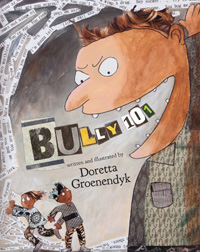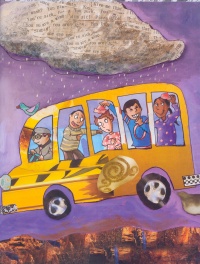| ________________
CM . . .
. Volume XIX Number 18. . . .January 11, 2013 
 |
Bully 101.
Doretta Groenendyk.
Charlottetown, PE: Acorn Press, 2012.
24 pp., hardcover, $18.95.
ISBN 978-1-894838-84-9.
Subject Heading:
Bullying-Juvenile fiction.
Grades 1-3 / Ages 6-8.
Review by Sabrina Wong.
** /4
|
| |
|

excerpt:
Welcome to school!
We have a great class,
a real wicked course
you can fight to pass.
If you're feeling low,
or a little undone,
blame someone else
in Bully 101.
Doretta Groenendyk's Bully 101 has a fresh approach to addressing bullying in schools. Rather than focussing on a singular bullying incident, Bully 101 shows the different forms and faces that bullying can take. Structuring the concept as a how-to-be-a-bully class is an innovative way to send an anti-bullying message, and the book presents bullying behaviours in a lesson framework: "If you're kind of down or a little blue, steal a kid's notebook in lesson two" (p. 3). The illustrations mirror the text and together emphasize that bullying is wrong. Children are asked to choose Kindness 202 as an alternative to Bully 101. The use of an rhyming scheme helps readers keep pace and rhythm through the book; however, the meter is sometimes a bit of a stretch, and the scheme is inconsistent from page to page.
 Bully 101 focuses on the actions of the bullies rather than the responses of the bullied. Even though this take on bullying may qualify the use of mean messages, giving child readers prefabricated insults seems contradictory to the message of the book which is to turn away from bullying towards kindness. It is troubling to see the use of the phrase "You're gay" including in multiple illustrative spreads as an example of a mean message. The other mean messages use words like "gross" or "worthless" (preface), or they speak obliquely to racism, "to where you came from" (preface). By linking homosexuality to these insults, it is validating "You're gay" as a slur. It is true that, for some people, the word "gay" is used to demean; however, including it in a collection of insults empowers those who use "gay" as an insult rather than recognizing and empowering those who refuse to use sexual orientation as a way to demean others. Bully 101 focuses on the actions of the bullies rather than the responses of the bullied. Even though this take on bullying may qualify the use of mean messages, giving child readers prefabricated insults seems contradictory to the message of the book which is to turn away from bullying towards kindness. It is troubling to see the use of the phrase "You're gay" including in multiple illustrative spreads as an example of a mean message. The other mean messages use words like "gross" or "worthless" (preface), or they speak obliquely to racism, "to where you came from" (preface). By linking homosexuality to these insults, it is validating "You're gay" as a slur. It is true that, for some people, the word "gay" is used to demean; however, including it in a collection of insults empowers those who use "gay" as an insult rather than recognizing and empowering those who refuse to use sexual orientation as a way to demean others.
Throughout the book, children who are the targets of bullies are portrayed looking upset, scared and lonely. They are never shown standing up to the bully or taking any proactive measures. At the end of the story, these figures are shown in Kindness 202 looking happy, but how they arrived in Kindness 202 is not explained, and it seems that this classroom stands alone as a refuge against bullying on the school bus, playground, computer lab, and the rest of the school environment. In this book, there are only six pages on being kind and 16 on being mean. Bully 101 may be able to more successfully convince child readers to be kind if the concept of Kindness 202 were more fully explored. Kindness 202 is simply stated as an alternative to Bully 101 for those who "prefer peace to pushing others around" (p. 18). The actions and intentions of bullies are described in detail over the course of the book, but the behaviours of kind people are skimmed over quickly with collage spreads sprinkled with kind words, lacking the catchy rhyming beat of the bullying sections. It should be noted that the illustrations by Jasper Fitch in this section are sweet and convey a child's conceptions of kindness. They show two people sharing a charmingly labelled "scate bord" [sic] (p. 21), others hugging, and sharing toys. The reader's eye is distracted from these drawings by cut-out letters spelling out various kind words. In other illustrative spreads, the use of letters cut out of magazines is also oddly disjunctive and passe. Since the backgrounds and figures have soft, painterly textures, it creates a sharp and amateurish appearance that detracts from Groenendyk's wonderfully expressive faces and figures.
It is clear from two of Groenendyk's earlier works, which have been shortlisted for the Lillian Shepherd Memorial Award for Illustration, that she possesses a lovely, vibrant and engaging illustrative style. For Bully 101, she has chosen to utilize collage, which can be a great medium for children's books since it allows the illustrator to feature different prints and textures. She is adept at communicating characters' feelings through her appealing cartoon style, and the layout of her figures creates a sense of animation in all of the scenes. In certain spreads, textual elements are used to great effect: one spread shows two isolated figures framed in a birdcage shape made of mean words (pp. 15-16), and on the next spread, a child opening a birdcage and freeing a bird (pp. 17-18). However, the use of a newspaper-like font for the mean messages in the collage gives some illustrations a dated look. Groenendyk effectively creates a visual shift from the Bully 101 section to the Kindness 202 section with a transition in colour palette from cool greens, grays, purples and blues to warm reds, oranges and yellows. Her visual language is
easy to read and shows an understanding of how to use illustrations to enhance the simple text of a picture book.
The book is "[g]eared towards primary-Grade 7" (book jacket) and perhaps would have benefited from focussing more tightly on a particular age range in order to address specific developmental needs and capabilities. The message of the book, that bullying is bad, can help younger school-age children to develop empathy and awareness of bullying, but while the drawings and tone of the book imply a younger audience, some of the vocabulary is too sophisticated for that age group (e.g. "demoralize," "humiliate"). Older children may find the look and feel of the book to be too young, and the message of the book to be overly simplified and trite for their more developed worldview. Since thoughts and actions are painted black and white, the generalized examples of bullying featured in this book may not resonate with them as they would for a younger audience.
Despite the vague audience, Bully 101 is still a timely book for addressing a major issue in schools. The book provides a way of broaching the topic of bullying; however, it should be used in conjunction with other activities and materials that provide other views of bullying and building acceptance. Groenendyk's book tells children to be kind to one another, but it does not provide any other strategies for dealing with bullies. Bully 101 would be a useful classroom aid for the primary grades beginning the discussion on bullies and bullying.
Recommended.
Sabrina Wong is a recent graduate of the UBC School of Library and Information Studies.

To comment
on this title or this review, send mail to cm@umanitoba.ca.
Copyright © the Manitoba Library Association. Reproduction for personal
use is permitted only if this copyright notice is maintained. Any
other reproduction is prohibited without permission.
NEXT REVIEW |
TABLE OF CONTENTS FOR THIS ISSUE
- January 11, 2013.
AUTHORS |
TITLES |
MEDIA REVIEWS |
PROFILES |
BACK ISSUES |
SEARCH |
CMARCHIVE |
HOME |

 Bully 101 focuses on the actions of the bullies rather than the responses of the bullied. Even though this take on bullying may qualify the use of mean messages, giving child readers prefabricated insults seems contradictory to the message of the book which is to turn away from bullying towards kindness. It is troubling to see the use of the phrase "You're gay" including in multiple illustrative spreads as an example of a mean message. The other mean messages use words like "gross" or "worthless" (preface), or they speak obliquely to racism, "to where you came from" (preface). By linking homosexuality to these insults, it is validating "You're gay" as a slur. It is true that, for some people, the word "gay" is used to demean; however, including it in a collection of insults empowers those who use "gay" as an insult rather than recognizing and empowering those who refuse to use sexual orientation as a way to demean others.
Bully 101 focuses on the actions of the bullies rather than the responses of the bullied. Even though this take on bullying may qualify the use of mean messages, giving child readers prefabricated insults seems contradictory to the message of the book which is to turn away from bullying towards kindness. It is troubling to see the use of the phrase "You're gay" including in multiple illustrative spreads as an example of a mean message. The other mean messages use words like "gross" or "worthless" (preface), or they speak obliquely to racism, "to where you came from" (preface). By linking homosexuality to these insults, it is validating "You're gay" as a slur. It is true that, for some people, the word "gay" is used to demean; however, including it in a collection of insults empowers those who use "gay" as an insult rather than recognizing and empowering those who refuse to use sexual orientation as a way to demean others.